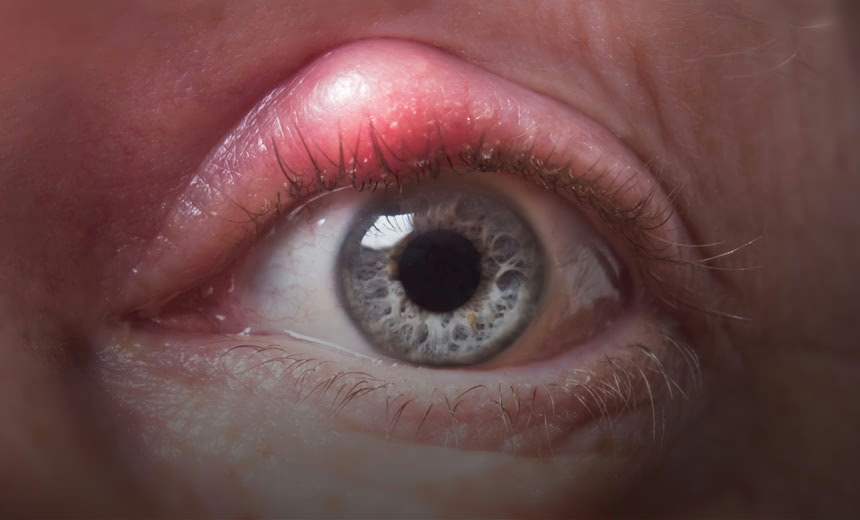Subscribe to eyeMatters periodic news
"*" indicates required fields

Blepharitis

Blepharitis is a chronic condition that involves inflammation of the eyelids. It occurs close to the lash line and is sometimes associated with dry eye conditions, bacterial eye infections and skin conditions such as acne rosacea.
Blepharitis can occur in children and adults of any age.
There are two main types of blepharitis:
- Anterior blepharitis: this affects the outside margins of the eyelid where the eyelashes are attached, often causing significant swelling
- Posterior blepharitis: this type of blepharitis occurs when the eyelids’ tiny oil glands (meibomian glands) dysfunction resulting in a blockage.
Many people experience both anterior and posterior blepharitis simultaneously. Some cases are mild whilst others are more severe. Blepharitis usually affects both eyes at the same time.
What causes blepharitis?
The exact cause of blepharitis is uncertain. There are a number of different factors associated with the development of the condition:
- Meibomian gland dysfunction
- Certain medications such as antihistamines and hormone replacement therapy
- Allergies (contact lens solution, makeup, certain eye drops or ointments)
- Acne rosacea
- Lash mites
- Seborrheic dermatitis (dandruff of the scalp and eyebrows)
- Changes in oestrogen levels such as menopause or pregnancy
- Bacterial infection.
Blepharitis can be caused by only one of the above factors or a combination of many.
What are the symptoms of blepharitis?
Blepharitis causes varying degrees of discomfort depending on the severity of the case. Common signs and symptoms include:
- Itchy, flaky eyelid margins
- Red/blood-shot eyes
- Foreign body sensation
- Excessive or frothy tears
- Crusty or sticky lashes
- Sensitivity to light
- Rough, scaly eyelids
- Excessive blinking.
It is a good idea to make an appointment with your optometrist or ophthalmologist as soon you experience any of the above symptoms.
How is blepharitis diagnosed?
Blepharitis is easily diagnosed. Your eye doctor will usually perform a slit-lamp microscope exam to observe your eyelids and eyelashes. The meibomian glands – situated along the eyelids just inside the eyelashes – will be observed and gently compressed to examine their discharge. Healthy meibomian glands produce a thin, oily secretion, whereas dysfunctioning glands will produce a thicker, waxy secretion, or, in worse cases, no secretion at all due to complete blockage. An eye doctor may also observe the meibomian glands with an infrared camera.
How is blepharitis treated?
Blepharitis is a condition that is managed rather than permanently cured. It can continue to present itself throughout a person’s lifetime. However, medication and professional or at home eyelid hygiene can provide relief and help to lessen the likelihood of the condition reoccurring.
Preservative-free antibiotic drops (or ointment), artificial tears and steroid eye drops may be prescribed temporarily to relieve dry eye or inflammation.
The mainstay of blepharitis treatment is eyelid hygiene. Warm compresses placed against the eye and gently massaged towards the margins for several minutes can help to loosen the crusts and unblock the glands. This can also be performed as a professional, in-house treatment using proper equipment.
There are several products available from your pharmacist or eye doctor designed especially for daily cleaning of the eyelid margins. In addition, your eye doctor may perform an in-house professional clean of your eyelid margins, much like your dentist professionally cleans your teeth every 6–12 months.
If acne rosacea is likely to be a factor in your blepharitis, an oral antibiotic called doxycycline may be prescribed for several months to improve your meibomian gland function from the inside out. A nutritional supplement containing omega 3 oils and micronutrients may also be prescribed.
Treatment can take weeks to several months. During this time you will be advised not to wear contact lenses and refrain from using eye makeup (or use very sparingly), as this can cause further irritation to the eye.
Prognosis
Serious complications of blepharitis are rare and are usually preventable if treatment is followed and eye hygiene is maintained. Always discuss any concerns you may have with your eye doctor.
The information on this page is general in nature. All medical and surgical procedures have potential benefits and risks. Consult your ophthalmologist for specific medical advice.
Date last reviewed: 2025-10-28 | Date for next review: 2027-10-28
